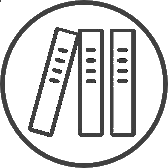Security Control helps you control which users have what type of access and to which pages through Security Templates, and which functions your organization does not intend to use at all through System Overrides.
Security Templates
Using templates is an easy way for you to manage the type of access that users in your organization have for each CLEARVIEW page. Each template is a combination of access types for each page and can be custom labelled for easy recall. The template can then be assigned to all users who should have that type of access, hence negating the need to select the access level for each page for each user.
The Security Templates page may be reached through the Security Control link under Admin on the navigation bar The row of labels that are located at the top left corner of a page, below the Clearview logo..
The different access levels are:
-
Function Not Available - the page won't be visible to the user.
-
Display Only - the user can only see the contents of the page but cannot enter any data nor make any changes.
-
Update - the user can see the contents and update existing information, but cannot add new data.
-
Full Access - the user can see the contents, add and make changes to it.
-
Full Access + Override - the user can see the contents, add and make changes to it, and modify locked content as well.
-
Custom - available only in the Settings tab, this option allows you to set the access level for each individual setting that was grouped under the function heading.
TO CREATE A NEW SECURITY TEMPLATE:
-
Open the Security Templates page.
-
Click on the Create button.
-
Type in the name that you'd like to refer to the template as in Template Name.
-
Select an access level from the drop-down list for each of the functions.
-
Ensure that the access levels are set for the functions listed in each of the tabs.
-
To set all the pages/functions listed in a tab to the highest access level, click on
 .
. -
To set all the pages/functions listed in a tab to the lowest access level, click on
 .
.
-
-
Click on the Create button to save the template.
If the access levels for the template that you are creating are similar to the access levels of an existing template, you can copy the access levels from the existing template and then edit them to save time. Here's how:
-
After Step 2, listed above, click on the Copy button.
-
Click on the name of the template that you want to copy the access levels from.
-
Change the Template Name.
-
Change the access levels, as required.
-
Click on the Create button to save the template.
Once a template is created, it can be assigned to a user either while creating the user in CLEARVIEW, or through the Update User page.
TO EDIT A SECURITY TEMPLATE:
-
A user can not update the template they are assigned to.
-
A user can only update templates for which they have the same or higher access level to all pages in the template.
-
Open the Security Templates page.
-
Click on the name of the template that you want to edit.
-
If you'd like to change the name of the template, type in the new name in Template Name.
-
Change the access levels by selecting them from the drop-down list next to each function, as required.
-
Click on the Update button.
TO DELETE A TEMPLATE:
Only templates that are not currently assigned to any user can be deleted.
-
Open the Security Templates page.
-
Click on the name of the template that you want to delete.
-
Click on the Delete button.
-
Click on the OK button in the confirmation request pop-up box A box with a prompt that opens up when you click certain links or buttons in Clearview..
System Overrides
Here's where you control which functions of CLEARVIEW your organization will use and which functions it won't.
The System Overrides page may be reached by:
-
Clicking on the Security Control link under Admin on the navigation bar The row of labels that are located at the top left corner of a page, below the Clearview logo..
-
Clicking on the System Overrides tab.
-
A function that is set as Active will be available to users in your organization.
Which users will have access to the function can be set through Security Templates or by setting the access level for each function for the user while creating the user or through the Update User page).
-
A function that is set as Inactive will not be accessible by any users in your organization.
Changing the status of a function to Inactive after users have already been created, will result in the function no longer being accessible to existing users as well.
TO INDICATE THE FUNCTIONS THAT YOUR ORGANIZATION WILL USE:
-
Open the System Overrides page.
-
Set the status of each function:
-
Select Active from the drop-down list for each function that your organization intends to use.
-
Select Inactive from the drop-down list next to each of the functions your organization does not intend to use.
-
-
Click on the Save button at the bottom of the page.
-
Click on the OK button in the confirmation pop-up box A box with a prompt that opens up when you click certain links or buttons in Clearview..

